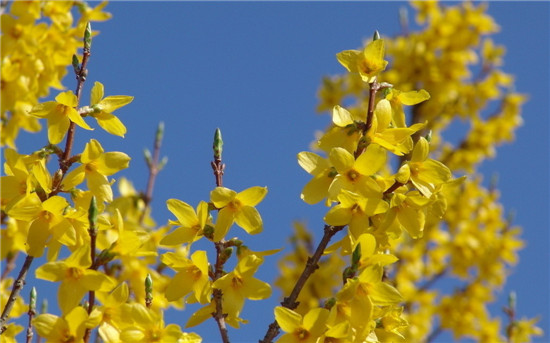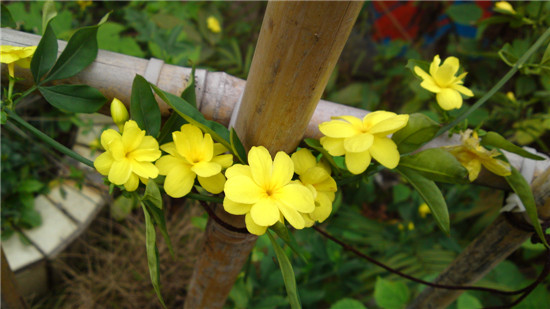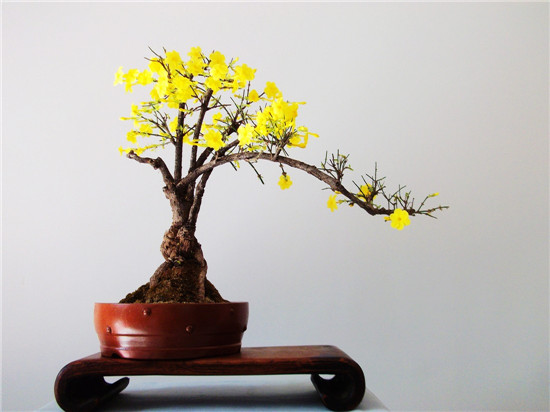Making and pruning of winter jasmine bonsai
Primrose is not only dignified and beautiful in color, but also has the excellent quality of being not afraid of cold power. It is one of people's favorite plants. Next, let's take a look at the production and pruning of primrose bonsai.

The materials for making primrose bonsai are mainly artificial cultivation and excavation of stout old piles in the wild because of their resistance to pruning and strong sprouting power. The method of re-cutting can be used to cut off the terminal buds and cultivate a certain crown after the plant grows to about 0.3 meters or certain design requirements. Or through certain shaping and pruning, the root buds can be removed at any time to promote its multi-branch flowering.
The main purpose of field excavation is to protect the root, keep the intact root system as far as possible, remove the disabled and dead root system, straighten out the root system, plant it deeply in the pot, and gradually carry out root lifting. The method of lifting the root is to fill the lower part of the basin with nutritious soil and add fine sand to the upper part. During cultivation, all the roots should be buried in the human basin, then compacted, watered and carefully managed.
After a stage of cultivation, the root system developed normally, and the whisker root grew in the cultured soil, which had deep roots and luxuriant leaves. At this time, you can gradually take out the fine sand, so that the upper roots are slowly exposed. After a certain period of training, the exposed roots have gradually aged, and the lateral roots are relatively stout, so the flowers and trees can be moved to the shallow basin. The root system should be fully protected and the original culture soil should be brought when transplanting. In this way, we can gradually cultivate a primrose bonsai with hanging roots and exposed claws, simple and vigorous.

Production method of primrose bonsai:
1. Flowerpot selection
Primrose bonsai is generally appropriate to use deep color purple sand pottery or glazed pottery, according to the shape of primrose bonsai to determine the shape of the flowerpot. Cliff-style primrose bonsai can be used with a deep thousand-barrel basin, sometimes to highlight the beauty of the roots, but also to use a shallow basin. The color of the flowerpot should be those that set off the beauty of primrose yellow florets, such as dark blue, light blue, dark or purplish red.
2. Bonsai modeling
Yingchun because the branches naturally droop, and the roots have characteristics, so it is very suitable to be processed into the hanging branch type and the root type, and often combine the two, the roots are exposed, while the trunk is made into a horizontal dry type or curved dry type, the twigs are brushed, with unique charm.
3. Pruning method
Cut off the branches after digging up the primroses, because too many branches will die when the roots are damaged, the branches are too short and the buds are not easy to pull out, and 1/3 of the roots are exposed. After planting, do not expose the sun in the shade, be careful not to water too much, wait until after survival to look at the shape of primroses, and trim them properly. To control the growth of primrose branches, too long will affect the overall shape of the treatment.

4. Basin-turning skills
Yingchun generally turns the basin every two years, and the time should be after the leaves fall in spring or autumn. When turning the basin, it can be combined with pruning the root system, cutting off the withered root and overlong root, in order to facilitate the development of fibrous root. Bean cake crumbs can also be placed at the bottom of the basin as base fertilizer. If you need to lift the root to welcome the spring, you can lift the root properly when planting, and cover the soil around the root. In the future, with the leaching of watering, the root will be naturally exposed.
Matters needing attention in pruning bonsai of primrose
Primroses like light, drought and cold tolerance, and do not have strict requirements for soil. Neutral sandy loam with good drainage is suitable, slightly acidic soil or light saline-alkali soil can also adapt, not resistant to stagnant water. Primrose bonsai can be mixed with rotten leaf soil and loam, or mature vegetable garden soil, which is rich in nutrients and soft in texture, which is suitable for the growth and development of primrose bonsai.
The bonsai of primrose needs to adjust the tree potential through pruning to save nutrients so that the branches are evenly distributed, the crown is neat and graceful, and the important thing is that it is conducive to more flowering. Whether the time for pruning primroses is appropriate or not is a key link in raising primroses.
The flower bud of primrose is formed on the branches of the first year, so it is not suitable to be pruned in autumn and winter. If pruned at this time, the branches with flower buds formed in summer will be cut off, resulting in no flowers to bloom. The most suitable pruning time for primrose bonsai is within 10 days after all the flowers have withered, leaving two or three bud holes in each branch.

After the primrose bonsai blossoms in spring, it will be trimmed once, cutting off all the branches of the year, leaving 1-2 teeth. After growing for a period of time, prune again and remove the weak branches according to the symmetry of the post and crown branches. If the branch grows too fast, it can be truncated again in late March or early April, and one of the lateral teeth can be erased according to the growth direction of the branch.
At the beginning of June, the bonsai of primrose should cut off the wheel branches, reverse branches and overlapping branches that do not need to be retained, and the parts where the branches are too dense should be thinned properly to facilitate light transmission. The pruning of primrose bonsai must be carried out strictly in accordance with the natural law of plant growth, which fully reflects the combination of natural beauty and artificial beauty of plants.
After two to three years of pruning and cultivation, a pot of old and colorful bonsai with roots instead of dried primroses is unfolded in front of us. After the shape is finalized, the excess branches and leaves should be cut and thinned every year to keep the tree shape unchanged.
The above is the whole content of the production and pruning of spring primrose bonsai for you. I hope this article can help you. Please continue to follow us.
Trim again and remove the weak branches according to the symmetry of the post and crown branches. If the branch grows too fast, it can be truncated again in late March or early April, and one of the lateral teeth can be erased according to the growth direction of the branch.
At the beginning of June, the bonsai of primrose should cut off the wheel branches, reverse branches and overlapping branches that do not need to be retained, and the parts where the branches are too dense should be thinned properly to facilitate light transmission. The pruning of primrose bonsai must be carried out strictly in accordance with the natural law of plant growth, which fully reflects the combination of natural beauty and artificial beauty of plants.
After two to three years of pruning and cultivation, a pot of old and colorful bonsai with roots instead of dried primroses is unfolded in front of us. After the shape is finalized, the excess branches and leaves should be cut and thinned every year to keep the tree shape unchanged.
The above is the whole content of the production and pruning of spring primrose bonsai for you. I hope this article can help you. Please continue to follow us.
Related
- Wuhan Hospital Iron Tree Blooming Result Was Instantly Frightened by the Gardener Master
- Which variety of camellia is the most fragrant and best? Which one do you like best?
- What is the small blue coat, the breeding methods and matters needing attention of the succulent plant
- Dormancy time and maintenance management of succulent plants during dormancy
- Minas succulent how to raise, Minas succulent plant pictures
- What are the varieties of winter succulent plants
- How to raise succulent plants in twelve rolls? let's take a look at some experience of breeding twelve rolls.
- Attention should be paid to water control for succulent plants during dormant period (winter and summer)
- Watering experience of twelve rolls of succulent plants
- Techniques for fertilizing succulent plants. An article will let you know how to fertilize succulent plants.



